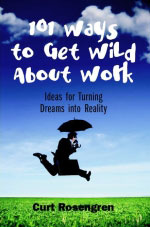How’s your job? A thrilling and exhilarating adventure, or little more than an increasingly boring way to bring home the bacon?
 Passion Catalyst Curt Rosengren is an awesome chap and a generous contributor to our latest issue of Kim & Jason magazine (on its way to Club K&J members as we speak…or as I write?) I have been reading his book, 101 Ways to Get Wild About Work, in small bites on airplanes as Kim and I have criss-crossed the country flying to speaking engagements. There are so many self-help books out there that it can sometimes be hard to tell the difference between them, but Curt’s really stands out.
Passion Catalyst Curt Rosengren is an awesome chap and a generous contributor to our latest issue of Kim & Jason magazine (on its way to Club K&J members as we speak…or as I write?) I have been reading his book, 101 Ways to Get Wild About Work, in small bites on airplanes as Kim and I have criss-crossed the country flying to speaking engagements. There are so many self-help books out there that it can sometimes be hard to tell the difference between them, but Curt’s really stands out.
One of the great things about children is that they see things with new eyes. Little things delight and astound them, sometimes only because they’ve never seen them before. As grown-ups we become jaded by the “same old, same old” and miss out on wonderful treasures that are right under our noses. If you are a veteran of motivational and self-help books, you’ll definitely want to check this book out. Curt did a great job of putting a fresh twist on age-old advice that made it new again, which invites the reader to see things with new eyes.
And if you’re more of a rookie when it comes to books like these, but you’re feeling stuck in a rut and yearn for a more exciting career and adventurous life, you’ll also want to give it a read. Impressively, Curt has been able to create something that is bite-sized but filling. Each chapter is only two or three pages long, but is packed with practical, real-world advice — and peppered with fun, too.
One of my favorite tips is #21: Jettison “Should” and Do What Feels Right. Here’s an excerpt:
Of the hundreds of thousands of words in the English language, the one that does the most to keep people from their dreams is “should.” In six short letters it convinces them to let their own needs and desires take a backseat to an external picture of what the world is supposed to look like. “I should be ‘successful’ (as defined by the dominant culture).” Or, “I should be responsible, or realistic, or focused on other people’s needs before my own, or…”
Often, those shoulds are so deeply ingrained that we aren’t even aware that we’re seeing the world through a should-created lens. We end up trapped in a false reality without ever realizing that alternative views exist.
The first step to getting beyond the shoulds is noticing that they exist to begin with. Here’s an idea to help you discover yours. Take a piece of paper and at the top of it put, “I should…” Then look at your ideas about your career. What “should” you do? Run a little mind-movie through your head about pursuing your passion. Does that kick up any shoulds? Does it run counter to the way you’re “supposed” to be? How about as it relates to family, or your role in society?
How about life in general? What “should” you do? How “should” you be?
The first step to overcoming shoulds is simply being aware of them. After you make the initial list, keep the piece of paper somewhere handy and keep adding to it as more shoulds occur to you over the coming week.
Once you have your list of shoulds, start exploring them. For each one, ask yourself, “Is this valid? Is this accurate? Where did this come from?” Some of them will be perfectly valid, and many will not. Some of them will be in alignment with what feels good and sustaining for you. Others may be completely out of whack.
In order to make decisions that are based on what is right for you, and not what you “should” do, you have to recognize where what is right for you and what you “should” do are at odds.
How often do you let the “shoulds” dictate how you spend your time?
With the inquisitiveness of a four-year-old, start questioning everything.
Start questioning the shoulds.
Curt Rosengren! I love how the blogosphere works . . . I used to read his blog regularly. (Okay, I will get back to reading it regularly. . .)
The problem of “should” is it create a fake world. The world of “should” only exists in our ego-dominated mind. The way I deal with it is to eliminate “should” altogether. Just rephrase it. Example:
I should do this. . .> I do this / I want to do this. / I don’t want to do this.
Great post, Jason!
Nice technique for dealing with the shoulds, Akemi.